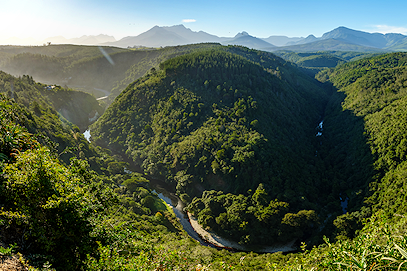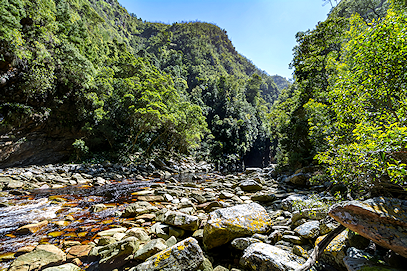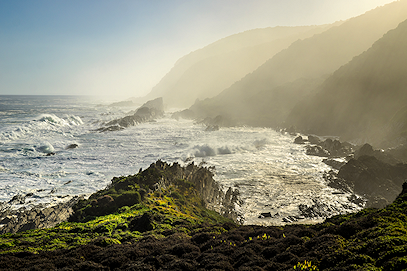The Tsitsikamma National Park protects a pristine stretch of coastline and indigenous forest in the Garden Route region of South Africa. The nearest major city is Port Elizabeth, which is 141km to the east, while Cape Town is 615km to the west. Many of the Garden Route tours offered by African Sky visit this magnificent coastal national park.
Need Advice?The Tsitsikamma National Park habitat is a rocky coastline rising sharply through Afromontane forests to fynbos on higher ground. Sections of the park also protect stretches of sandy beach.

Tsitsikamma is a ramblers dream. Twelve hiking trails take you into an enchanting world of a tangled bush dominated by forest giants such as the Outeniqua yellowwood, bastard ironwood, and stinkwood. The main trail at Tsitsikamma is the Otter Trail (48km), considered South Africa's finest coastal walk. The trail leads west from the Storms River mouth to Nature's Valley, crossing a landscape of lonely beaches, rocky shores, tumbling mountains bisected by rivers and ravines, and gentle plateaus covered by leucadendron, ericas, and proteas.
From the cosmopolitan city of Cape Town to the Overberg and Garden Route regions, a delightful private tour that ends with a safari in Addo is sure to be enjoyable.
This luxury adventure combines a visit to the Garden Route with an unforgettable safari at Shamwari - the top private game reserve in the southern part of South Africa.
Departing and returning to Cape Town, this short but informative private tour explores the highlights of the Garden Route from a base on the shores of the Knysna Lagoon.
Tsitsikamma National Park is home to many bird species. Birders can enjoy the pristine natural habitat via various hiking trails. You will constantly be aware of their presence as they call each other to acknowledge and alert others to your presence. They aren't as easy to spot in the forest canopy but keep a look-out for the Knysna Loerie and the Grey Cuckoo Shrike.
Tsitsikamma is home to the world-famous Otter Trail hiking route. It is one of the most scenic routes along the southern coastline of Africa. The entire Otter takes a few days to finish and has to be booked at least a year in advance. The first section, known as the Waterfall, accommodates day visitors and is easy to complete.
The Storms River itself, along with all the activities it offers, is one of the main attractions in the area. Explore its beauty and have a fun day out. Available activities include kayaking through the gorge, black water tubing, horse trails, canopy tours, zip line tours, or simply hiking. The river's mouth is also the starting point for the Otter Trail and is a must-see.
Your most memorable experiences will take advantage of the primordial forests and the handsomely rugged coastline.



The Tsitsikamma region is situated in both the Western and Eastern Cape and can be accessed from the north and south. Guests traveling to Tsitsikamma will be welcomed at OR Tambo International Airport or Cape Town International and assisted in transferring to a domestic flight to either George or Port Elizabeth Airport, depending on your itinerary.
The area is approximately 200km south of Port Elizabeth and 70km north of Plettenberg Bay. Guests traveling to Tsitsikamma will have the absolute pleasure of driving through one of the most beautiful winding roads in South Africa in a private, air-conditioned vehicle. The region is a popular destination to combine with safari areas such as Addo Elephant National Park.
Tsitsikamma has a very moderate climate, with rainfall occurring in summer and winter, usually at night. Daytime activities can be enjoyed throughout the year, making the perennially green landscape the perfect destination for adventure seekers. The rainfall is the highest from May to October.
Tsitsikamma is accessible throughout the year, with November to April being the peak season. It is also the only African area where rainfall occurs throughout the year. Ocean and river temperatures drop during the winter from April to September, but it is still comfortable if you plan water-based activities.
Tsitsikamma is a Khoikhoi word where tsi means "clear" or "clean" and kamma means "water" or "river." Thus, it could be translated into, for example, "clean, clean water" or "clear clear river." The Khoikhoi were nomadic pastoral people who moved around to provide their livestock with enough grazing. They had cattle, goats, and fat-tail sheep, but preferred not to eat their cattle as it was a sign of wealth. They instead used cows for milk. They also harvested bulbs, roots, and fruit from the land. The Khoikhoi that occupied Tsitsikamma was known as the Houteniqua, meaning "man laden with honey." The Khoikhoi arrived in the Southern Cape between 2 500 and 2 000 years ago.
Shell middens on the coast indicate that Stone Age people occupied the land long before the Khoikhoi arrived. The Europeans only arrived in this area in the eighteenth century. Tsitsikamma National Park is now grouped with Wilderness and Knysna to form the Garden Route National Park. When Tsitsikamma National Park was established in 1946, a marine protected area was also incorporated along the 80km coastline. It was the first marine national park in Africa. Worldwide this is one of the largest single-unit Marine Protected Areas with a 'no take' policy that includes fishing. It provides a baseline for fisheries research on endangered line fish species.
The animals that are most likely to be encountered are Chacma baboons and vervet monkeys. These primates are plentiful; food must not be left unattended, as they will steal it. Numerous antelope species occur, the most common being bushbuck. Other antelope species include common duiker, steenbok, grysbok, klipspringer and blue duiker. The secretive Cape mountain leopard is the largest predator, only seen on camera traps. Caracal is spotted occasionally, and Cape clawless otters can be seen going into the ocean before high tide. From the high cliffs, southern right whales and humpback whales can be spotted in season. Indo-Pacific bottlenose dolphins occur throughout the year.
Several bat species come out of their caves at dusk to feed on insects. Numerous nocturnal species like large-spotted genet, bush pigs, porcupines, and striped pole cats move around in the small hours of the morning. The indigenous forest is home to many birds, of which the Knysna Turaco (Loerie) is the best known. During the day, the calls of the red-chested cuckoo, Knysna Turaco, and Burchell's coucal can be heard, and at night they are replaced by the calls of Cape eagle owl, spotted eagle owl, fiery-neck nightjar, and common thick knee. In pristine sections of the forest, the beautiful narina trogon will mesmerize bird watchers. At night, the forest transforms into a mystical wonderland when the fireflies come out.
Tsitsikamma is known for its cliffs, and massive river valleys, not to mention the ancient Cape Fold Mountains to the north. The bedrock consists of heavily weathered metamorphic rock. The bedrock is heavily jointed, meaning that weaker zones in the rock form parallel to each other. One can see this on the coast, where the weaker areas weathered away along the joints forming little gaps that resemble 'slices' in the rock. Geologically, Tsitsikamma falls within the Table Mountain Group, within the larger Cape Supergroup. The original rock formed in this group was deposited in a shallow marine environment 510 to 400 million years ago.
The park is best known for its lush indigenous forests with towering yellowwoods. Other massive species include the red elder, Cape ash, hard pear, and black stinkwood. Between these trees, you may also find 'monkey rope' or wild vine that the primates use to move through the forest. There are, however, much more plant species within the four types of fynbos. These four fynbos species are short Asteraceae fynbos, tall fynbos, Passerina fynbos and Restoid fynbos. Tsitsikamma also contains semiaquatic flora and aquatic plants. The semiaquatic flora includes plants like reeds, sedges and bulrushes. Aquatic plants include species such as pondweed and seagrass.
Tsitsikamma is an adventurer's paradise. With so many things to do in the area, it takes time to decide what to do first. One of the favorites amongst tourists and locals is kayaking up the Storms River. The trip through the gorge offers scenic views of the river, the ocean, and vegetation. Another popular attraction can be reached after a short walk into the famous Tsitsikamma forests. The Big Tree, so-called as it is an incredible 36.6m tall with a circumference of 9m, is a must-see. If you like forest adventures, a canopy tour is in order. Visitors can zip line from tree to tree through the forest over giant ferns.
The park is also the home of the world-renowned Otter Trail, a five-day hiking expedition that must be booked a year in advance due to its popularity. The Waterfall Trail, the first section of the Otter Trail, is an excellent alternative for a day walk and takes approximately 3 hours to complete. Still, we advise you to spend some time swimming and admiring the Waterfall at the pool. Adrenaline seekers can leap from the Bloukrans Bridge – the highest bungee jump in the world. Mountain biking, Segway tours, tubing, golfing, scuba diving, and many more activities are available in the area, so let us know your preferences.